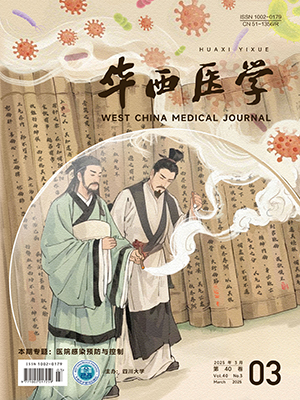【摘要】 目的 探讨高原地区桡神经损伤的治疗效果,并总结影响疗效的因素。 方法 回顾性分析2005年6月-2010年6月收治的桡神经损伤并有完整随访资料的54例患者,其中男40例,女14例;年龄8~69岁,平均32.6岁。开放性损伤5例,闭合性损伤49例;左侧26例,右侧28例。受伤原因:刀伤5例,医源性损伤(手术牵拉伤、被钢板挤压伤)10例,肱骨干骨折合并桡神经损伤39例。神经损伤类型:桡神经完全断裂12例;大部分断裂15例;挫伤27例,挫伤长度1.5~4.5 cm。所有患者均有典型的感觉及运动功能障。采用神经吻合修复27 例,神经松解减压27例。骨折均用钢板内固定。 结果 所有患者手术均顺利,术后切口均I期愈合,无手术相关并发症发生。54例均获随访16~24个月,平均18个月。骨折于术后8~14个月达临床愈合。末次随访时根据中华医学会手外科上肢周围神经功能评定标准,神经吻合的27例中,获优14例,良8例,差5例;神经松解减压术治疗的27例均获优。总优良率为91%。 结论 上臂桡神经损伤宜早期手术修复,神经吻合的疗效较神经松解减压术差。
【Abstract】 Objective To explore the therapeutic effect on radial nerve injuries in plateau area, and to analyze the influencing factors. Methods The clinical data of 54 patients with radial nerve injuries who were treated between June 2005 and June 2010 were retrospectively analyzed. The patients included 40 males and 14 females and aged 8-69 years (averaged 32.6 years old). Of these 54 patients, 5 were open injuries, 49 were closed injuries; 26 were on the left side, and 28 were on the right sides. Causes of injuries included: 5 direct cut injuries, 10 iatrogenic injuries (including traction injuries and crush injuries by steel plates), and 39 humeral shaft fracture and radial nerve injuries. Types of nerve injuries included: 12 complete radial neurotmesis, 15 partial radial neurotmesis, and 27 radial contusions (with contusion length ranged 1.5-4.5 cm). All patients had radial nerve injuries experienced significant motor dysfunctions. Among these patients, 27 underwent nerve anastomosis, the remaining 27 were treated by nerve decompression; all fractures were treated with internal fixation with steel plates. Results During the average follow-up of 18 months (16-24 months), all 54 patients completely recovered from radial nerve injuries without any complications. The time for fracture healing ranged 8-14 months. According to the evaluation standards for radial nerve functional recovery, developed by the Chinese Medical Association, among the 27 cases treated by nerve anastomosis, 14 were “optimal”, 8 were “fair”, and 5 were “bad”; and all 27 cases treated by nerve decompression were “optimal”. Conclusion It is suggested to have early surgical treatment for the upper arm radical nerve injuries. The nerve decompression had better curative effects than the nerve anastomosis does.
Citation: QIN Guilan,LI Ping. Therapeutic Effect on Radial Nerve Injuries in Plateau Area. West China Medical Journal, 2011, 26(12): 1836-1838. doi: Copy
Copyright © the editorial department of West China Medical Journal of West China Medical Publisher. All rights reserved




